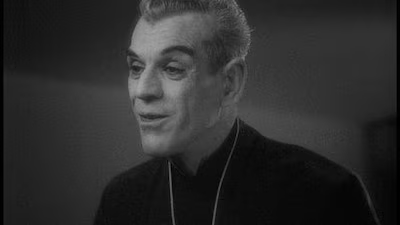Edgar G. Ulmer

About
Biography
Filmography
Family & Companions
Notes
There is some question as to whether Mr. Ulmer was born in 1900 or 1904. Sources are divided on this issue. This database is using 1900 based on information from the 1930s.
Biography
Prolific director of relatively minor fare who nevertheless created a wide assortment of odd, low-budget gems. Originally a stage actor and set designer, Ulmer did his first film work as an art director as early as 1919, became an assistant to theater impresario Max Reinhardt and crossed the Atlantic several times, working in both theater and film. After serving as F.W. Murnau's assistant for six years, he made his feature debut in Germany, co-directing with Robert Siodmak the landmark documentary-style slice-of-life drama, "People on Sunday" (1929).
In 1931 Ulmer settled in the US, working first as a production designer and then a director of second features. He made one major studio picture, the Universal horror classic, "The Black Cat" (1934), but otherwise worked for a variety of low-budget outfits known collectively and colloquially as "Poverty Row" studios; Ulmer also worked on a number of films outside the Hollywood production apparatus, as with several Yiddish-language films. At "Poverty Row" in the 40s, he turned out a number of fast-paced programmers, including the grim and influential film noir classic "Detour" (1946), and entertaining programmers such as "Bluebeard" (1946) and "Ruthless" (1948).
Ulmer himself declared that he preferred to work in this milieu ("I did not want to be ground up in the Hollywood hash machine") and, despite budgetary constraints, he was awarded a degree of creative freedom that he would not have had with the major studios. The result is a distinctive personal stamp present on many of his films, partly thanks to his roots in the German expressionist movement and his experience in design.
Filmography
Director (Feature Film)
Cinematography (Feature Film)
Writer (Feature Film)
Producer (Feature Film)
Art Director (Feature Film)
Art Department (Feature Film)
Production Companies (Feature Film)
Life Events
1918
Designer for Decla-Bioscope film company, Berlin
1919
Worked as set designer and assistant director on Max Reinhardt's stage productions
1922
Worked with Murnau as assistant and art director on "The Last Laugh" and "Faust"
1923
Travelled to US with Max Reinhardt's production, "The Miracle"; stayed to design sets for Martin Beck on Broadway and Universal in Hollwood
1925
Returned to Germany; became director F.W. Murnau's assistant
1929
Returned to Berlin to collaborate with Robert Siodmak directing the semi-documentary, "Menschen am Sontag/People on Sunday"
1933
Directed first film in USA, "Mr. Broadway"
1934
Teamed Boris Karloff and Bela Lugosi in "The Black Cat"
1945
Helmed the cult classic "Detour"
1946
Formed own production company Mid-Century
1965
Made final film, "The Cavern"
Photo Collections
Videos
Movie Clip












Trailer
Family
Companions

Bibliography
Notes
There is some question as to whether Mr. Ulmer was born in 1900 or 1904. Sources are divided on this issue. This database is using 1900 based on information from the 1930s.












